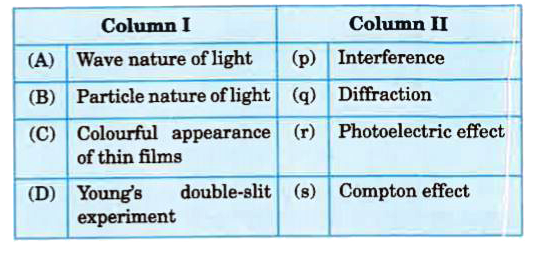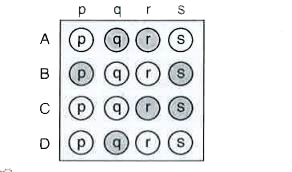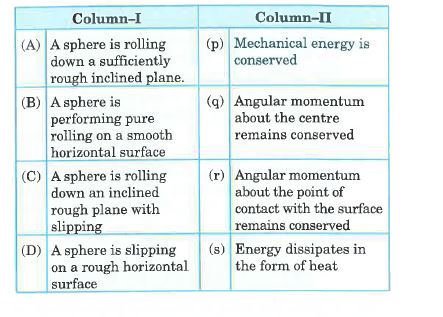Each question contains statements given in two columns, which have to be matched. Statements in column-I are labelled as A, B, C and D whereas statements in column-II are labelled as p, q, r and s. Match the entries of column-I with appropriate entries of column-IL. Each entry in column-I may have one or more than one correct option from column-II. The answers to these questions have to be appropriately bubbled as illustrated in the given example. If the correct matches are A→(q,r),B→(p,s),C→(r,s) and D→(q), then correctly bubbled matrix will look like the following:

In a region of space, only electric or magnetic or both are possible , Other fields are to be neglected .

The correct Answer is:A→(p,r) B→(p,r) C→(q,r,s) D→(q,r,s)
aTO(P,R) p-Projecta a charge not parallel to a uniform
electric field then it follows parabolie path and its kinetic energy also changes.
r-Many combinations of electric and magnetic field can do that.
B→(p,r) p-Projects a charge parallel to uniform field then it will move in a straight line but with changing kinetic energy.
r-One component of electric force may balance magnetic force and the other
component may change ita speed.
C→(q,r,s) q-If charge is at rest in magnetic field then it experiences no force.
r-Electric force can balance magnetic force. S-If no fields are present, then the net force is zero.
D→(q,r,s) q-If charge is moving in a magnetic field then its kinetic enery remains constant.
r-When electric force balances magnetic force, then kinetic energy of charged particle remains constant .
s - In case of no fields, there would not be any force to change the kinetic energy of the particle.
Topper's Solved these Questions
- MOVING CHARGES AND MAGNETISMBOOK - MODERN PUBLICATIONCHAPTER - MOVING CHARGES AND MAGNETISMEXERCISE - COMPETITION FILE (INTEGER TYPE QUESTIONS)
10 Videos
- MOVING CHARGES AND MAGNETISMBOOK - MODERN PUBLICATIONCHAPTER - MOVING CHARGES AND MAGNETISMEXERCISE - CHAPTER PRACTICE TEST
13 Videos
- MOVING CHARGES AND MAGNETISMBOOK - MODERN PUBLICATIONCHAPTER - MOVING CHARGES AND MAGNETISMEXERCISE - COMPETITION FILE (ASSERTION TYPE QUESTIONS)
10 Videos
- MAGNETISM AND MATTERBOOK - MODERN PUBLICATIONCHAPTER - MAGNETISM AND MATTEREXERCISE - CHAPTER PRACTICE TEST FOR BOARD EXAMINATION
16 Videos
- NUCLEIBOOK - MODERN PUBLICATIONCHAPTER - NUCLEIEXERCISE - CHAPTER PRACTICE TEST FOR BOARD EXAMINATION
15 Videos
Similar Questions
Each questions contains statements given in two columns, which have to be matched. Statements in column - I are labelled as A,B,C and D, whereas statements in column-II are labelled as p,q,r and s. Match the entries of column-I with appropriate entries of colomn-II . Each entry in column-I may have one or more than one correct option from column - II. The answers to these questions have to be appropriately bubbled as illustrated in the given example, if the correct matches are A→(q,r),B→(p,s),C→(r,s)andD→(q).

View SolutionEach question contains statements given in two Columns, which are to be a matched. Statements in Column-I are labelled as B A, B, C and D, whereas statements in Column-II C are labelled as p, q, r and s. Match the entries of D Column-I with appropriate entries in Column-II. Each entry in Column-I may have one or more than one correct option from Column-II. The answers to these questions have to be appropriately bubbled as illustrated in the given example, if the correct matches are A→(q,r),B→(p,s),C→(r,s) and D→(q)

View Solution
Knowledge Check
Each question contains statements given in two columns, which have to be matched. Statements in Column I are labelled as A, B, C and D whereas statements in Column II are labelled as p, q, r and s. Match the entries of Column I with appropriate entries of Column II. Each entry in Column I may have one or more than one correct option from Column II. The answers to these questions have to be appropriately bubbled as illustrated in the following example. If the correct matches are A-4, A-r, B-p, B-, C-r, C-s and D-q, then the correctly bubbled matrix will look like the following:

Match the element in column I with the property mentioned in column II
 A(q) , (s)B(p), (q)C(q), ( r)D(p),(q),(s)
A(q) , (s)B(p), (q)C(q), ( r)D(p),(q),(s)
Each question contains statements given in two Columns, which are to be a matched. Statements in Column-I are labelled as B A, B, C and D, whereas statements in Column-II C are labelled as p, q, r and s. Match the entries of D Column-I with appropriate entries in Column-II. Each entry in Column-I may have one or more than one correct option from Column-II. The answers to these questions have to be appropriately bubbled as illustrated in the given example, if the correct matches are A→(q,r),B→(p,s),C→(r,s) and D→(q)

View SolutionEach question contains statements given in two columns, which have to be matched. Statements in column-I are labelled as A and D whereas statements in column-II CP are labelled as p, q, r and S. Match the entries of DP S column-I with appropriate entries of column-II. Each entry in column-I may have one or more than one correct option from column-II. The answers to these questions have to be appropriately bubbled as illustrated in the given example, if the correct matches are A→(q,r),B→(p,s),C→(r,s)andD→(q).

View SolutionEach question contains statements given in two Columns, wihich are to be matched. Statements in Column-I are labelled as A, B, C and D whereas statements in Column-II are labelled as p, q, r and s. Match the entires of Column-I with appropriate entries of Column-II. Each entry in Column-I may have one or more than one correct option from Column-II. The answers to these questions have to be appropriately bubbled as illustrated in the given example. If the correct matches are A→(q,r),B→(p,s),C→(r,s)andD→(q), then correctly bubbled matrix will look like the following:

View SolutionEach question contains statements given in two columns, which have to be matched. Statements in Column I are labelled as A, B, C and D whereas statements in Column II are labelled as p, q, r and s. Match the entries of Column I with appropriate entries of Column II. Each entry in Column I may have one or more than one correct option from Column II. The answers to these questions have to be appropriately bubbled as illustrated in the following example. If the correct matches are A-4, A-r, B-p, B-, C-r, C-s and D-q, then the correctly bubbled matrix will look like the following:

Match the element in column I with the property mentioned in column II

View SolutionEntries of Column-I are to be matched with entrices of Column-II. Each entry of Column-I may have the matching with one or more than entries of Column-II

View SolutionEntries of Column-I are to be matched with entrices of Column-II. Each entry of Column-I may have the matching with one or more than entries of Column-II

View SolutionEntries of Column-I are to be matched with entrices of Column-II. Each entry of Column-I may have the matching with one or more than entries of Column-II

View Solution
